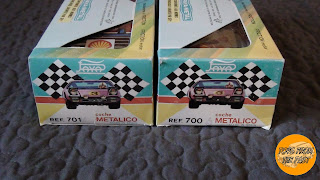These cars
were also acquired last Christmas among many other toys from the late 70s and
early 80s. It comes from the gigantic lot that somehow came out during the last
months of 2011, and that quickly distributed among Spanish collectors and
sellers. That’s why so many toys from this époque are now listed in sites like todocoleccion.net.
This
explains that if you try to search information about Payá Metal on the
Internet, you’ll just find classified ads, auctions and sellers. There’s no
information at all about this interesting series by the Spanish classic toymaker
Payá.
DATSUN (seems to be a 126x from 1971) (Ref. 7011)
 |
What it
seems proved is that, even though plastic toys were very common since the mid
60s, Payá started producing tin toys again in 1974 or 1975. The cause for this
strange decision was the 1973 oil crisis. The OAPEC (Organization of Arab
Petroleum Exporting Countries) plus some other oil-producing countries proclaimed
an embargo to all countries that supported Israel during the Yom Kippur War (October
1973). The price of the oil barrel increased around 400% or 500% that year.
Payá, as
well as many other Spanish toymakers couldn't afford such prices. Oil was scarce
so the production had to continue withtin. The situation wouldn’t improve in a
short-term (it would even worsen in 1979), bringing a second “tin-Age” in the
toy industry, which would last until the early to mid 80s.
Payá had
the know-how, so they just had to return to the old manufacturing methods, and
created a new line, “Payá-Metal” (References 70xx and also 80xx) which would be
one of the most important ones during the late 70s and early 80s. Not all parts
of the toys were made of tin. The base and wheels were still made of
plastic.
To my
knowledge, this line included many different cars and even some tractors,
planes and machines. Some were even cable-controlled. Most humble versions (these) came with friction motors, although in the lower part of the cars there's a little hole which was used for the cable on the cable controlled versions (which were exactly the same models).
FERRARI (seems to be a 250 P5 from 1968) (Ref. 7006)
 |
| Note the stickers at the back corners of the car. These are often missing, even when MIB ("Mint in Box")! |
These two
are some of the first references in Payá-Metal series, 7006 and 7011. There
were also different models made: the first ones (these, among others) were
prototypes and concept cars (for example: Mercedes C-111 or Porsche 917) and
came in paper boxes decorated with hand-made illustrations. These cars have a
characteristic cockpit made of transparent plastic in which the pilot (a
plastic helmet) can be seen. In this first series there were also other slightly more elaborated, battery operated toys with lights and sound (references 80xx), and included more “common”
vehicles of that time,
Later releases would include cars like Seat 124, 1430 or 132, Renault 12 or 15, Ford Fiesta or Chrysler 150… even with different decorations each (police, firemen…). These were packed in a more modern box decorated with photographs of the different models available (one box fits all). These cars came with windshield and decorated interior, but no pilot.
Later releases would include cars like Seat 124, 1430 or 132, Renault 12 or 15, Ford Fiesta or Chrysler 150… even with different decorations each (police, firemen…). These were packed in a more modern box decorated with photographs of the different models available (one box fits all). These cars came with windshield and decorated interior, but no pilot.
Other Spanish brands, like Román, Jyesa or Rico would build very similar toy
cars at the same time, releasing very interesting models, with very
funny and colourful decorations.
 |
| Beautiful drawings in the 1st gen. boxes. Note that they are labelled in English and French for export. |
 |
| Two different boxes for Datsin (Printed and Stamped) (Ref. 7011) |
 |
| Two different boxes for Ferrari (Printed and Stamped) (Ref. 7006) |
FACTS AND
FIGURES:
- Name: FERRARI and DATSUN (Ref. 7006 and 7011)
- Scale: 1:24 (approx.)
- Year: Around 1976
- Company: Payá (Spain)
- Size: approx. 22 cm












No comments:
Post a Comment